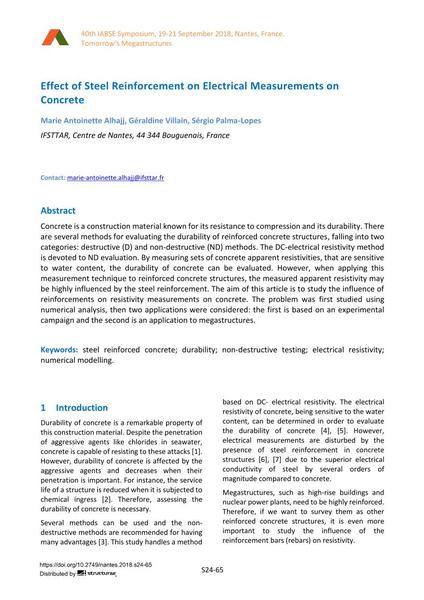Effect of Steel Reinforcement on Electrical Measurements on Concrete

|
|
|||||||||||
Détails bibliographiques
| Auteur(s): |
Marie Antoinette Alhajj
(IFSTTAR, Centre de Nantes, 44 344 Bouguenais, France)
Géraldine Villain (IFSTTAR, Centre de Nantes, 44 344 Bouguenais, France) Sérgio Palma-Lopes (IFSTTAR, Centre de Nantes, 44 344 Bouguenais, France) |
||||
|---|---|---|---|---|---|
| Médium: | papier de conférence | ||||
| Langue(s): | anglais | ||||
| Conférence: | IABSE Symposium: Tomorrow’s Megastructures, Nantes, France, 19-21 September 2018 | ||||
| Publié dans: | IABSE Symposium Nantes 2018 | ||||
|
|||||
| Page(s): | S24-65 | ||||
| Nombre total de pages (du PDF): | 8 | ||||
| DOI: | 10.2749/nantes.2018.s24-65 | ||||
| Abstrait: |
Concrete is a construction material known for its resistance to compression and its durability. There are several methods for evaluating the durability of reinforced concrete structures, falling into two categories: destructive (D) and non-destructive (ND) methods. The DC-electrical resistivity method is devoted to ND evaluation. By measuring sets of concrete apparent resistivities, that are sensitive to water content, the durability of concrete can be evaluated. However, when applying this measurement technique to reinforced concrete structures, the measured apparent resistivity may be highly influenced by the steel reinforcement. The aim of this article is to study the influence of reinforcements on resistivity measurements on concrete. The problem was first studied using numerical analysis, then two applications were considered: the first is based on an experimental campaign and the second is an application to megastructures. |
||||
